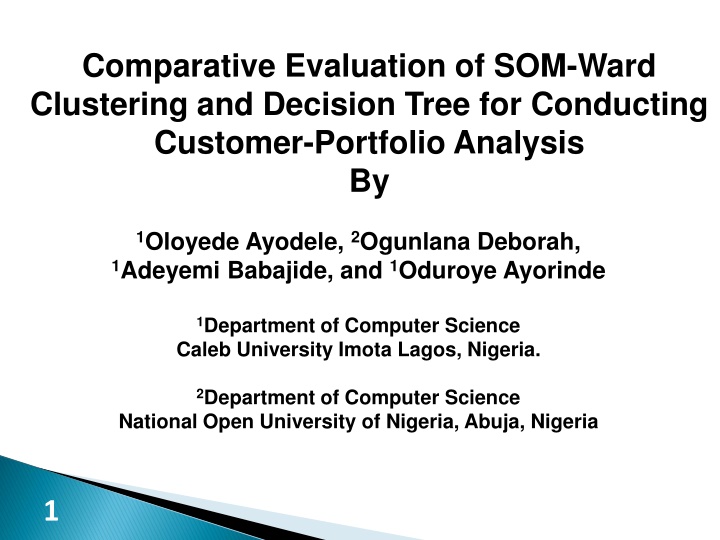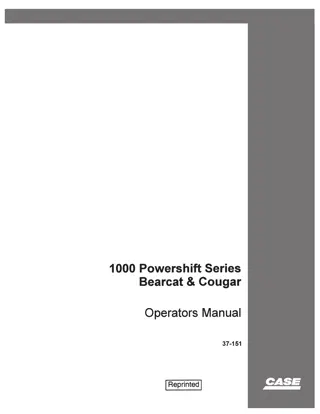
Hybrid Approach for Customer Portfolio Analysis
This study compares the use of SOM-Ward clustering and decision trees in conducting Customer Portfolio Analysis to improve customer relationships and maximize profits. The hybrid approach combines data mining techniques to extract hidden information efficiently from customer data. By analyzing customer behavior, spending patterns, and demographics, companies can better meet customer demands and enhance their overall profitability.
Download Presentation

Please find below an Image/Link to download the presentation.
The content on the website is provided AS IS for your information and personal use only. It may not be sold, licensed, or shared on other websites without obtaining consent from the author. If you encounter any issues during the download, it is possible that the publisher has removed the file from their server.
You are allowed to download the files provided on this website for personal or commercial use, subject to the condition that they are used lawfully. All files are the property of their respective owners.
The content on the website is provided AS IS for your information and personal use only. It may not be sold, licensed, or shared on other websites without obtaining consent from the author.
E N D
Presentation Transcript
Comparative Evaluation of SOM-Ward Clustering and Decision Tree for Conducting Customer-Portfolio Analysis By 1Oloyede Ayodele, 2Ogunlana Deborah, 1Adeyemi Babajide, and 1Oduroye Ayorinde 1Department of Computer Science Caleb University Imota Lagos, Nigeria. 2Department of Computer Science National Open University of Nigeria, Abuja, Nigeria 1
Introduction Statement of the Problem Aim and Objectives Literature Review Methodology Result and Discussion Expected Contribution to Knowledge References 2
Introduction For a while, the goal of existing business organizations has been redirected from being product-oriented organizations. In the industry, it has been usual practice that to attract new customers is cost-effective compare to keeping the existing ones (Kim et al, 2016). Park (2015) researched that a 5% increase in customer retention leads to a 25 95% increase in company profit. to customer-centric Therefore, most organizations cast their attention on improving relationships with their clients for satisfaction. Data mining approach is suitable for the extraction of hidden information from customer data warehouses. This technique also preferred in conducting Customer Portfolio Analysis (CPA) efficiently, as a result, allocating limited resources is allocated to numerous customer groups according to the corporate strategy efficiently. 3
In this study, we propose a hybrid approach that combines the Self-Organizing clustering and decision trees for conducting CPA. (Buttle, 2014). Map (SOM)-Ward Then, a decision tree approach will be utilized to identify the segments with high developmental potential, and also to improve the relationship between customers behavior, spending amounts, demographic and characteristics. This analysis enhances companies to make necessary in meeting the demands of their customers and to reduce their overhead costs and maximize profits of the entire customer base. 4
Analyzing customers base so as to retaining and attracting the most important customers still stands the main problem facing companies in this modern age. The process of conducting customer-portfolio analysis (CPA) makes most existing customer relationship management systems (CRMS) lack ability to extract concealed information from pool of data stored in customer warehouses, to conduct market segmentation due to the implementation techniques used. 7
AIM: The aim of this work is to compare the Evaluation of SOM-Ward Clustering and DT for Conducting Customer- Portfolio Analysis OBJECTIVES : The specific objectives are; To review the existing systems in other to detect the problems associated with them. Develop SOM-Ward and DT Models to simulate the prediction performance of the decision tree. Evaluate the developed system against SOM, DT, and Ward Clustering individually using recognition accuracy and recognition time as evaluation metrics. 9
The SOM is able to compress the input data while the topological relationship of data structure is preserved (Kohonen, 2001). As a result, the SOM algorithm serves as an important tool for segmentation analysis and is commonly used as an analytical tool for conducting clustering tasks in various business related areas, including market segmentation (Kaski, et al, 2014). Deboeck (2016) comparing two clustering methods (SOM-Ward and K-means clustering), drew the conclusion that SOM-Ward clustering resulted in better clusters representations than K-means alone. The Decision Tree; a supervised data mining technique was used to break large data into smaller sets using two-way or multi-way splits Berry and Linoff (2004). 10
Methodology In this paper, a two-level hybrid approach that combines denoted as (SOM-Ward) and decision trees (DT) data mining technique is proposed. Self-Organizing Maps-Ward s clustering The dataset used in this study were acquired from the loyalty card system, containing 1,480,662 customers, and sales information from several department stores. SOM-Ward clustering was used to analyze customer segmentation, by dividing the client base into distinct segment with comparable attributes. A Decision Tree was used to break large datasets into manageable sizes for proper identification which distinguished between high spending customers and low spending ones. 11
Result and Discussion The result of the prediction performance of DT shows that the overall accuracy of the model is 72.6%. 82.8% of the high spending customers are correctly classified, while only 62.4% of the low spending customers are correctly classified. Table 1. The prediction performance of the decision tree 12
This work is expected to contribute to knowledge as stated below: The combined model is more detailed and accurate than that provided by either model used alone, thus more actionable information about the customer base for marketing purposes could be retrieved. information provided by the 29
A hybrid approach combining SOM-Ward and decision trees (DT) data mining technique has been proposed to conduct customer portfolio analysis. The decision tree was employed to gain insight into whether there are significant determinants for distinguishing between high- and low-spending customers. The results of the analysis demonstrate that the combined method of the SOM-Ward clustering and the Decision Tree can potentially be effective in conducting market segmentation.
Kim, S., Jung, T., Suh, E., Hwang, H.(2016): Customer Segmentation and Strategy Development Based on Customer Lifetime Value: A Case Study. Expert Systems with Applications 31, 101 107 Park, H., Baik, D (2015): A Study for Control of Client Value using Cluster Analysis. Journal of Network and Computer Applications 29, 262 276 (2006) Buttle, F.(2014): Customer Relationship Management Concepts and Tools. Butterworth-Heinemann, Oxford Terho, H., Halinen, A.(2015): Customer Portfolio Analysis Practices in Different Exchange Contexts. Journal of Business Research 60, 720 730 Kohonen, T.: Self-Organization and Associative Memory. Springer, New York (2012) Ward, J.H.(2014): Hierarchical Grouping to Optimize an Objective Function. Journal of the American Statistical Association 58, 236 244 30
THANKS FOR LISTENING 31












